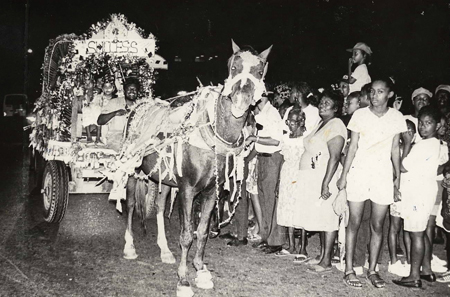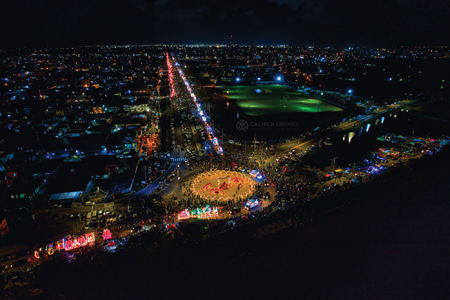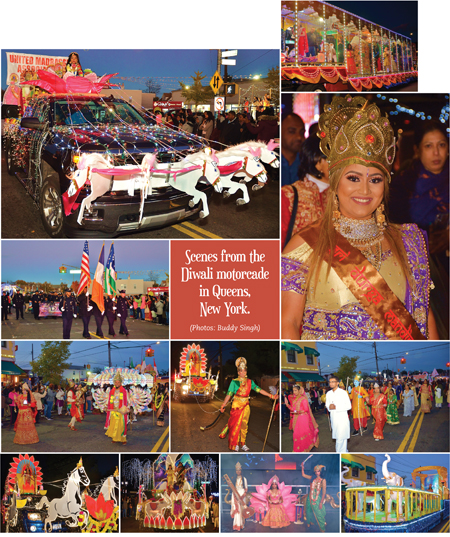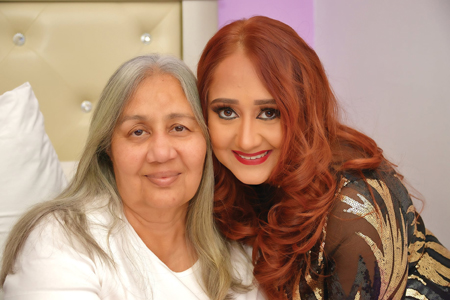Heritage: A Diwali Spectacle Like No Other

The Diwali Motorcade, a cherished national tradition in the Caribbean nation of Guyana, is now also a showstopper annual event in Queens, New York.
[Left] The late Pandit Reepu Daman Persaud (L), former Minister of Agriculture and Parliamentary Affairs, founded the Guyana Hindu Dharmic Sabha (GHDS) in 1974, when he also started the tradition of the Diwali motorcade, which has grown to become one of Guyana’s most prominent cultural events.
Raised along the roof of South America, among miles and miles of lush forest, Dolly Lall-Singh and many others across Guyana customarily rose from their slumber to the crowing of roosters and a warm breeze enveloping their mosquito nets.
But on the days leading up to Diwali, Dolly’s wake-up routine took on a whole different aura as anticipation of celebrating Lord Ram’s return home swept across Guyana, a nation that is home to over 800,000 people, 25 percent of whom identify as Hindus.
The first batch of these East Indians came to Guyana in 1838 after signing bonded contracts with their British colonial rulers to work as laborers on sugar plantations. Many Hindus and some Muslims from regions like Uttar Pradesh and Bihar willingly boarded ships from Calcutta, India, to build new lives in a far-off, unknown land, while others were tricked into this historic dislocation through misleading contracts.
Over time, East Indians became Guyana’s single largest ethnic group, eventually branching out from sugar plantations and delving into all aspects of economic and political life. Throughout the generations over a couple of centuries, Guyanese Hindus worked hard to preserve the centuriesold culture of their roots. “The Indian diaspora has admirably managed to maintain and even enhance their celebrations in distant parts of the world, not only embracing Hinduism as a way of life but also by keeping traditions alive for future generations,” says Vindhya Persaud, president of Guyana’s Hindu Dharmic Sabha and Minister of Human Services and Social Security.
 Persaud is the daughter of the late Pandit Reepu Daman Persaud, former Minister of Agriculture and Parliamentary Affairs and Guyana’s longest- serving politician. In January 1974, the elder Persaud founded the Guyana Hindu Dharmic Sabha (GHDS), a religious and cultural organization that promotes spiritual and cultural education. Comprised of eight praants, or branches, the GHDS has built over 125 affiliated mandirs (temples) throughout Guyana.
Persaud is the daughter of the late Pandit Reepu Daman Persaud, former Minister of Agriculture and Parliamentary Affairs and Guyana’s longest- serving politician. In January 1974, the elder Persaud founded the Guyana Hindu Dharmic Sabha (GHDS), a religious and cultural organization that promotes spiritual and cultural education. Comprised of eight praants, or branches, the GHDS has built over 125 affiliated mandirs (temples) throughout Guyana.
[Right] A modest float from one of the first few Diwali motorcades in Guyana.
Under the umbrella of GHDS, many of the country’s famous cultural events of the Indian diaspora have been created—such as Naya Zamana, a signature dance and theatrical production, and Kala Utsav, a festival of arts. However, the most popular is the Diwali Motorcade, a massive procession of beautifully decorated and illuminated floats depicting various themes found in Hindu scriptures.
Horse-drawn carts, tractors, and low bed trailers: the modest beginnings of a national Guyanese tradition
With few decorations and limited creativity, Pandit Reepu set out to lead Guyana’s first Diwali motorcade on the eve of Diwali in 1974. The motorcade commenced with an invocation havan, followed by a parade consisting of a handful of horse-drawn carts, tractors, and low-bed trailers adorned with photo frames of Hindu deities, bright fabrics, and tassels. Several children dressed up as Gods and Goddesses sat overhead, surrounded by mandir kirtan groups singing bhajans.
 The parade began at Shri Krishna Mandir in Campbellville, Georgetown, Guyana, and made its way to the east coast in Demerara, grabbing people’s attention from near and far. It concluded at the LBI Hindu Temple.
The parade began at Shri Krishna Mandir in Campbellville, Georgetown, Guyana, and made its way to the east coast in Demerara, grabbing people’s attention from near and far. It concluded at the LBI Hindu Temple.
[Left] An ariel view of the motorcade in Georgetown, Guyana, 2022. (Photo: Calipers Drones)
“My father had a strong desire to unite Guyanese people across the country, and the impact was evident in the annual motorcade,” Persaud reveals. “It simply exceeded his expectations.” For the first time, all races— Muslims, Hindus, and Christians—were eager to celebrate together as the motorcade sent a powerful call for unity aligning with the simple Sanskrit theme Vasudhaiva Kutumbakam, or the world is one family. Today, hundreds of thousands throng and line the seawall to admire over 30 strikingly adorned floats portraying scenes from the Ramayana.
The Diwali Motorcades cruises into Queens, New York.
News of the motorcade’s success reached many who shifted abroad, including Dolly Lall-Singh, who knew Pandit Reepu as a political figure and family friend as she grew up in Little Diamond, Guyana.
Unhappy with the lack of diversity and culture available to her and her children in New York in 1969, Singh began to divide her time between New York and Guyana, using every opportunity she could to expose her children to their roots. “Most Guyanese people have roots in India, and it always hurt me to have my religion being taught in the conditions that they were in when I was growing up. The cultural things I learned were supposed to be taught in spiritual institutions, not in a bottom house,” Singh asserted. “We deserved better.”
Dolly knew that the Indo-Guyanese population would grow in Queens, New York. Despite several challenges, her foresight led her to shoulder the role of a promoter of Indian culture, organizing fundraiser after fundraiser to help build Hindu temples across the borough. But it wasn’t enough. In the late 90s and early 2000s, she went on to form the Divya Jyoti Association, a nonprofit organization fostering Indian culture in Richmond Hill, Queens, which has fondly grown to be known as “Little Guyana.”
“When I was growing up in Guyana, we cleaned our homes, dressed up in new clothes, and attended Lakshmi Puja for Diwali. Afterward, we would bring out our diyas and line them up in the front yards, along verandah rails, and on the fences. It was always a happy occasion, and I wanted to bring that same Diwali joy to Queens,” beamed Dolly.
“What better way to do that than to recreate the Diwali Motorcade experience in Queens?” she thought.
Parallel to the GHDS’s first motorcade experience, the first Diwali Motorcade in New York commenced in 2002 with an invocational havan at the Arya Spiritual Center Grounds with a handful of fairy-lit vehicles showcasing children clad in scintillating attire, crawling down Liberty Avenue—a strong effort she believed helped the community feel closer to their ancestors.

Little Guyana’s showstopper
Today, the Guyanese population has grown to be the fifth-largest immigrant population in New York City and second largest in Queens, according to the 2019 American Community Survey by the U.S. Census Bureau—with over 10,000 people standing in a trance by nearly 20 illuminated floats in the Queens’ annual Diwali Motorcade.
Among the thousands of attendees, Cuban photographer Louis Nelson, aka Kon Boogie, fervently admits he’s afraid to blink, fearing he would miss a moment.
Dolly, her daughter Lakshmee, and the Divya Jyoti Association team have dedicated the past 20 years to keeping the tradition alive while showcasing the community’s finest talent.
At present, the celebration commences with an invocational havan and prayer chanting before elaborately decorated cars, vans, trucks, and trailers that inch down Liberty Avenue. Aside from the Divya Jyoti Association float—which leads the procession—hundreds of spectators flock their way through “Little Guyana” to catch a glimpse of the string of extravagant vehicles, each paying reverence to the gods and goddesses incarnated in divinely dressed youngsters.
Dave Nandkumar, an annual attendee since the motorcade’s inception, has worn many hats—from assuming the role of Lord Vishnu for the Divya Jyoti float to performing an invocational pushpanjali dance at the opening held at Arya Spiritual Center Grounds—and continues to praise the evolution of the community’s Diwali celebrations.
“Diwali is very dear to my heart, and I love that our community hosts this event. It’s like a spiritual reset for me and ignites energies to complete the year and await the new,” the local artist and educator beamed.
Just like the motorcade in Guyana, the event wraps up with a cultural show of devotional singing and dance performances from local and international talent. A team of panelists evaluates each float based on illumination, creativity, artisanship, beauty, music, and punctuality. Cash prizes are awarded to the winners.
Meanwhile, the motorcade in Guyana has become a global tourist attraction
Technology has undoubtedly allowed for a colossal transformation of the original GHDS motorcade in Guyana from its humble beginnings. Recent floats are magically transformed into carefully designed masterpieces—embellished with lights and mechanical innovations to create a movement for popular depictions such as the return of Lord Ram and Mother Sita from Ayodhya, demonstrating how the pathways were lit to welcome them home.
As many as 35 floats participate in the GHDS’s Diwali Motorcade, with crowds of people funneling their way to line the seawall, waiting to be mesmerized by the imaginative depictions of Hindu gods and goddesses and luminosity trickling about. The motorcade still commences at the Shri Krishna Mandir in Campbellville but now concludes at the LBI Community Centre Grounds, where people congregate for an evening of festive fireworks and cultural programming, not to mention cheering for winning displays bestowed with sought-after prizes.
 Through its branches, the GHDS has formed eight motorcades across Guyana in Upper Corentyne, Central Corentyne, East Berbice, West Berbice, East Bank Demerara, West Demerara, Essequibo, and Georgetown/East Coast Demerara—collectively becoming the single most significant cultural event in Guyana cherished by people beyond its borders.
Through its branches, the GHDS has formed eight motorcades across Guyana in Upper Corentyne, Central Corentyne, East Berbice, West Berbice, East Bank Demerara, West Demerara, Essequibo, and Georgetown/East Coast Demerara—collectively becoming the single most significant cultural event in Guyana cherished by people beyond its borders.
[Left] Dolly Lall-Singh Singh (L), with her daughter Lakshmee Singh. The duo and their team at the Divya Jyoti Association have dedicated the past 20 years to keeping the Diwali motorcade tradition alive in Queens, New York.
The GHDS’s Diwali Motorcade celebrates its 50th Anniversary this year and plans to amplify the essence of togetherness and showcase the Indo-Guyanese experience as the nation’s true wealth.
“Guyana will always be home of the Diwali Motorcade,” Vindhya Persaud says proudly. “There’s truly no place like celebrating at home.”
Ashley Kooblall is a NYC-based storyteller weaving community through her commitment to fostering youth at the Bhuvaneswar Mandir in Queens. She is a big believer that what we do for each other is what survives, and because of this, she records traces of tradition, culture, and modernity by promoting the Indo-Caribbean experience as a universal one.
Enjoyed reading Khabar magazine? Subscribe to Khabar and get a full digital copy of this Indian-American community magazine.
blog comments powered by Disqus











